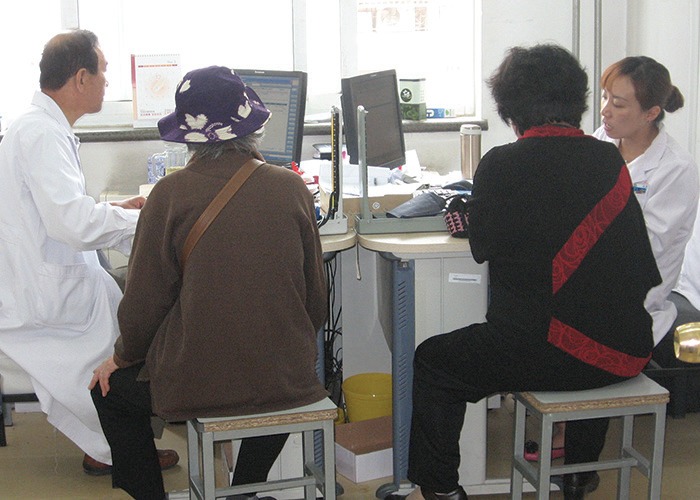Between 1949 and the late 1970s, health care in China was organised on a three-tier system. Paramedics or ‘barefoot doctors’ provided basic primary care in neighbourhood clinics. They would refer patients with problems beyond their skill levels to district hospitals, and only the most complex problems would be managed at large municipal or regional centres.
The ‘reform and opening-up’ policy since the late 1970s ushered in a market system that allowed private and foreign enterprise to act as catalysts for rapid economic growth. In the health sector, this market reform resulted in the development of large and well-equipped hospitals. The freedom to choose among the public meant that the majority opted to see hospital specialists, and this led to the gradual demise of primary care. Today, hospitals in China are overcrowded, consultations are short, and perverse financial incentives encourage over-investigation, over-medication, and inappropriate hospitalisation.1–3
PRIMARY CARE FACILITIES
The severe acute respiratory syndrome (SARS) epidemic in 2003 further highlighted the weak public health and primary care infrastructure. However, it was not until 6 years after the SARS epidemic when meaningful redevelopment of primary care started, which was a key component of the Chinese government’s most ambitious ever health reform plan. Community health clinics and township hospitals are expected to be the main primary care providers for urban and rural areas, respectively.4
By 2011 there were approximately 7800 community health centres and 25 000 smaller satellite stations covering over 90% of the 0.7 billion urban population.5 They provide a broad range of services over and above the management of common illnesses. There is an emphasis on prevention and public health. Traditional Chinese medicine, with its strong focus on individuals, the doctor–patient relationship and prevention, align well with the recent introduction of general practice.6
By 2011 there were about 37 000 township hospitals for rural residents.5 Unlike community health clinics which solely provide primary care, township hospitals are currently offering both primary and secondary care, including small surgeries and inpatient services, mainly due to the lack of resources and large geographical region. Some township hospitals in suburban areas are being transformed to community health centres. In remote rural areas, many village clinics have been set up to increase the healthcare coverage.

Parallel consultations in a room in a community health clinic, Beijing May 2011.
Photo: E.Ng
GENERAL PRACTICE
In 2011 there were 80 000 registered GPs in China, compared to the estimated need of 180 000 for urban China, but the large majority of them have only received very brief vocational GP training.7 The government aims to train an additional 300 000 within 10 years, with a target of two to three GPs for every 10 000 urban and rural residents.4 In 2011 the new ‘5+3’ GP training programme was introduced, with 3 years’ postgraduate GP training following a 5-year undergraduate medical course. GP trainees will spend 27 months in hospital rotations and 6 months in community clinics.8
One important problem is the serious shortage of GP trainers but trainer courses are being established, some in conjunction with foreign partners including the UK. Another challenge is the need to improve confidence in GPs and the understanding among the public of the roles of community clinics.9,10 Many people still prefer hospital specialists to GPs, even for minor conditions and despite geographical inconvenience. Attracting bright, newly-qualified doctors to primary care is difficult due to poor remuneration but this is being addressed. State-run health insurance schemes now provide higher reimbursement of expenditures in primary care clinics than in hospitals, and the idea of a primary care ‘gate-keeping’ role is being introduced in many places.
The national health reform has pledged an additional investment of CNY850 billion for 2009–2011 (or CNY202 per capita per year), of which a considerable amount was devoted to the infrastructure of primary care.11 Putting this in context, in 2011, the average cost of an outpatient visit to a community clinic and a township hospital were CNY82 and CNY48, respectively; compared to CNY180 per hospital outpatient appointment and CNY6632 per admission.5 A good primary care system would therefore have a dramatic benefit by reducing healthcare expenditures and health inequalities across the 1.3 billion population in China.
REFERENCES
- 1.Browne D. The long march to primary health care in China: from a collectivism to market economics. Public Health. 2001;115(1):2–3. doi: 10.1038/sj.ph.1900742. [DOI] [PubMed] [Google Scholar]
- 2.Eggleston K, Li L, Meng Q, Lindelow M, Wagstaff M. Health service delivery in China: a literature review. Health Econ. 2008;17(2):149–165. doi: 10.1002/hec.1306. [DOI] [PubMed] [Google Scholar]
- 3.Chinese Academy of Social Sciences. The analysis and prediction of the social position in China: 2011. Beijing: Chinese Academy of Social Science Press; 2011. [in Chinese] [Google Scholar]
- 4.Yip W, Hsiao W, Chen W, et al. Early appraisal of China’s huge and complex health-care reforms. Lancet. 2012;379(9818):833–842. doi: 10.1016/S0140-6736(11)61880-1. [DOI] [PubMed] [Google Scholar]
- 5.People’s Republic of China Ministry of Health. Statistical bulletin on the development of health services in China: 2011. 2012. [in Chinese]. http://www.moh.gov.cn/publicfiles/business/htmlfiles/mohwsbwstjxxzx/s7967/201204/54532.htm (accessed 20 Aug 2012)
- 6.Tang J, Liu B, Ma K. Traditional Chinese medicine. Lancet. 2008;372(9654):1938–1940. doi: 10.1016/S0140-6736(08)61354-9. [DOI] [PubMed] [Google Scholar]
- 7.The Xinhua News. China uses education reform and health reform to relieve the storage of general practitioner [in Chinese] Xinhua News. 2012. 6 Dec: http://news.xinhuanet.com/politics/2011-12/06/c_111221925.htm (accessed 20 Aug 2012)
- 8.State Council, People’s Republic of China. Opinions of the establishment of the general practitioner system, government document. 2011. [in Chinese] http://www.gov.cn/zwgk/2011-07/07/content_1901099.htm (accessed 20 Aug 2012)
- 9.Yang Y, Yang D. Community health service centers in China, not always trusted by the populations they serve? China Economic Review. 2009;20:620–624. [Google Scholar]
- 10.Bhattacharyya O, Yin D, Wong S, Chen B. Evolution of primary care in China 1997–2009. Health Policy. 2011;100(2–3):174–180. doi: 10.1016/j.healthpol.2010.11.005. [DOI] [PubMed] [Google Scholar]
- 11.Chen Z. Launch of the health-care reform plan in China. Lancet. 2009;373(9672):1322–1324. doi: 10.1016/S0140-6736(09)60753-4. [DOI] [PubMed] [Google Scholar]


